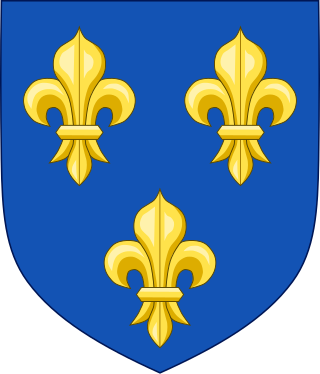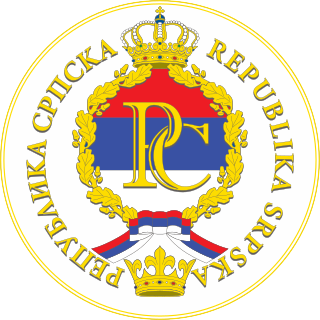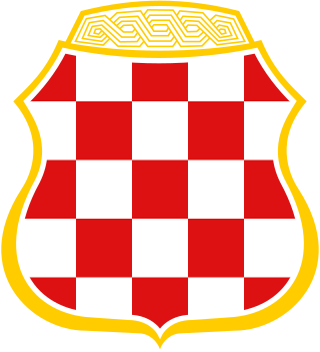
The fleur-de-lis, also spelled fleur-de-lys, is a common heraldic charge in the shape of a lily. Most notably, the fleur-de-lis is depicted on the traditional coat of arms of France that was used from the High Middle Ages until the French Revolution in 1792, and then again in brief periods in the 19th century. This design still represents France and the House of Bourbon in the form of marshalling in the arms of Spain, Quebec and Canada, for example.

The Arms of Canada, also known as the Royal Coat of Arms of Canada or, formally, as the Arms of His Majesty the King in Right of Canada, is the arms of dominion of the Canadian monarch and, thus, also the official coat of arms of Canada. In use since 1921, it is closely modelled after the royal coat of arms of the United Kingdom, with French and distinctive Canadian elements replacing or added to those derived from the British version.

The flag of Bosnia and Herzegovina contains a medium blue field with a yellow right triangle separating said field, and there are seven full five-pointed white stars and two half stars top and bottom along the hypotenuse of the triangle.

The coat of arms of Bosnia and Herzegovina was adopted in 1998, replacing the previous design that had been in use since 1992 when Bosnia and Herzegovina gained independence. It follows the design of the national flag. The three pointed shield is used to symbolize the three major ethnic groups of Bosnia, as well as allude to the shape of the country.

Herzeg-Bosnian Canton is one of the ten cantons of the Federation of Bosnia and Herzegovina, a political entity of Bosnia and Herzegovina. It is the largest canton by area and eighth by population. The local government seat is in Livno, while the assembly is in Tomislavgrad.
There is currently no official flag for the Federation of Bosnia and Herzegovina. The federation is part of the state of Bosnia and Herzegovina. The federation adopted its own flag in 1996, but the flag and associated coat of arms were deemed unconstitutional by the Constitutional Court of Bosnia and Herzegovina in 2007 and now it is considered to be a "de facto" flag. The federation has not yet adopted a new flag, anthem or coat of arms; instead the symbols of the central state are used for official purposes as a provisional solution.

The coat of arms of the Republic of Serbia consists of two main heraldic symbols which represent the identity of the Serbian state and Serbian people across the centuries: the Serbian eagle and the Serbian cross.

The West Herzegovina Canton is one of the cantons of the Federation of Bosnia and Herzegovina. The West Herzegovina Canton is in the Herzegovina region in the southwest of Bosnia and Herzegovina. Its seat of government is in Široki Brijeg, while other municipalities within the Canton are Grude, Ljubuški and Posušje. It has 94,898 inhabitants, of whom more than 98% are ethnic Croats.

The Seal of the State of Texas was adopted through the 1845 Texas Constitution, and was based on the seal of the Republic of Texas, which dates from January 25, 1839.

The Great Seal of the Commonwealth of Pennsylvania is the state seal for the Commonwealth of Pennsylvania. According to the state's website, the seal was authorized by the Pennsylvania General Assembly in 1791, and is "a symbol of authenticity which verifies that proclamations, commissions and other papers of state are legal and official."

The coat of arms of Montenegro was officially adopted by the law passed in the Parliament on 12 July 2004. It is now the central motif of the flag of Montenegro, as well as the coat of arms of the Armed Forces of Montenegro. It was constitutionally sanctioned by the Constitution proclaimed on 2 October 2007.

The flag of Republika Srpska within Bosnia and Herzegovina was adopted on 24 November 1992. The flag is a rectangular tricolor with three equal horizontal bands of red, blue and white. It is almost identical to the civil flag of Serbia, but with different aspect ratio of 1:2 instead of 2:3 and slightly different color shades.The flag is the same used at the Misiones Province in Argentina.

The flag of the abolished Croatian Republic of Herzeg-Bosnia (1992–96) consists of three equal size, horizontal stripes in the pan-Slavic colours arranged in Croat tricolour: red, white and blue. In the middle is the coat of arms of the Croatian Republic of Herzeg-Bosnia stylised with a triple wattle at the top. In 1997 and 1998 the Constitutional Court of the Federation of Bosnia and Herzegovina ruled its usage as a canton flag unconstitutional, since the symbols of cantons and municipalities cannot represent just one ethnic group.

Since 2011, Libya currently does not have an official national emblem. The Constitutional Declaration issued by the National Transitional Council on August 2011 defines the flag of Libya, but does not make any provisions for a coat of arms.

The Coat of Arms of Sarajevo is the coat of arms of the city of Sarajevo, the capital of Bosnia and Herzegovina.

The Seal of Republika Srpska with the description: the flag of Republika Srpska and the Cyrillic letters "РС" ("RS"), the red-blue-white tricolor are in the center of the seal, twisted with the golden Oak leaves, a traditional pre-Christian symbol sacred to most Slavs. On the edge of the seal there is an inscription Republika Srpska. The open crown of Kotromanić is shown in the bottom of the seal and the seal itself is topped with a heraldic royal crown.

The coat of arms of Mexico is a national symbol of Mexico and depicts a Mexican (golden) eagle perched on a prickly pear cactus devouring a rattlesnake. The design is rooted in the legend that the Aztec people would know where to build their city once they saw an eagle eating a snake on top of a lake. The image has been an important symbol of Mexican politics and culture for centuries. To the people of Tenochtitlan, this symbol had strong religious connotations, and to the Europeans, it came to symbolize the triumph of good over evil.

The Macedonian lion is an unofficial symbol of North Macedonia. After the independence of the Republic of Macedonia from Yugoslavia, the lion was proposed as a coat of arms of the new independent state several times.

The Coat of arms of the Croatian Republic of Herzeg-Bosnia is the variation of the historical Croatian coat of arms in the form of a stylized Polish heraldic shield with triple wattle on top. It is bordered by golden lines.
















